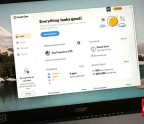
The big-screen laptop trend of recent has been moving from a 17.3-inch display with a widescreen 16:9 aspect ratio to a 16-inch 16:10 panel that results in a more compact and portable package with nearly the same screen real estate. Despite numerous refreshes over the past few years, the Dell XPS 17 still resides between these two popular panel sizes, with a 17-inch 16:10 display that’s roomier than a 16-inch 16:10 display, but not quite as wide as a 17.3-inch 16:9 display. The result is an absolutely massive display for media editing, multitasking, and perhaps some light gaming.
Inside, the serves up the latest Intel and Nvidia silicon. Our test system pairs a 13th-gen Core i7 CPU with RTX 4070 graphics. Dell prioritizes a thin enclosure over raw power, however, for this content creation laptop and opts for a low-wattage RTX 4070 that can’t match the frame rates of gaming laptops with full-wattage RTX 40-series GPUs. And while the display’s sheer size is certainly impressive, its 60Hz refresh rate is meh. Further, it’s merely an IPS panel and not an OLED, which graphics pros and hobbyists can rightly expect at this price. We’d steer content creators toward the similarly priced or that boast large OLED displays.




